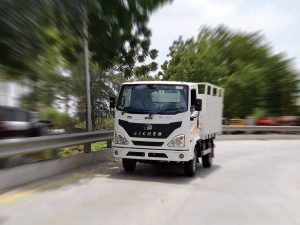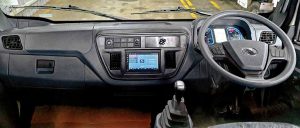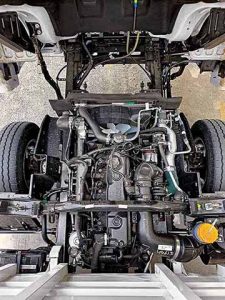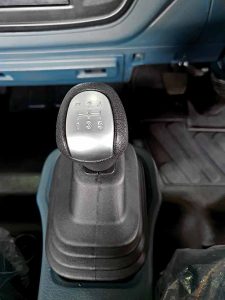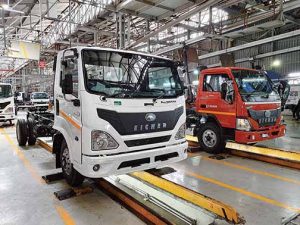Story & Photos:
Bhargav TS
Parked on the test track within the VE Commercial Vehicles (VECV) plant at Pithampur, the two Pro 2000 series make a pretty sight. They are a new addition to the range of CVs VECV makes. Comprising of two truck models – Pro 2049 with a GVW of five-tonnes, and Pro 2095 with a GVW of 10.7-tonnes, the Pro 2000 series signals a significant change at the Light and Medium-Duty (LMD) level. It also hints at modularity, and is one of the most versatile platforms to roll out of VECV in recent times. Developed in a span of the last three to four years involving extensive feedback from customers and operators in their respective segments, the two trucks have arrived at a time the CV industry is reeling under a slowdown. Looking modern and pointing at an effort to dial superior productivity, the Pro 2049 and Pro 2095 come with industry-first features like disc brakes all-round (the Pro 2095 comes with pneumatically actuated drum brakes), advanced telematics with real-time driver coaching and an infotainment system. Highlighting safety, comfort and efficiency, the Pro 2049 and Pro 2095 sport an all-new safety cabin that is built on a new line. Unlike the ‘legacy’ cabin, which was updated from time-to-time, and measures two-metres in width, the cab of the Pro 2049 and Pro 2095 measures 1.8 m and two-metres respectively.
Engineered to aid VECV to address the exacting market requirements, the day cabs of the two Pro 2000 series trucks (with a sleeping arrangement), flaunt ‘Pegasus’ business grille and clear lens headlamps with DRLs built-in. Hinting at a technological edge with features like a pasted windshield, the trucks display good fit and finish standards. There’s good attention to quality and aesthetics too. A result of extensive benchmarking against the competition, and by looking at similar products offered in other markets, the two Pro 2000 series trucks are engineered to make them fit for exports as well. Made unique by the fact that the cabs are built on a new cab-line, which was designed and developed by the company after a long gap of 33 years, the Pro 2049 and Pro 2095 stand out. The three-piece bumper contributes to the modern and distinct appearance. Seeming to keep the connection with the first Eicher-Mitsubishi truck that rolled out of Pithampur in the early 80s, the tapering window-line provides a good near-side view. It also helps to manoeuvre with ease. Placed behind the door, the footrest is protected from dust and water splash. While Pro 2049 may look a bit toy-ish and cute from a three-fourth angle, both the Pro 2049 and Pro 2095 are at home in an urban environment.
Equipped with a cargo body that measures 3177 mm in length, the Pro 2049 provides a good view ahead from the driver’s seat. The large front windshield and the windows help. It is the same case with the Pro 2095. Had in either of the five cargo body sizes at 14.1 ft., 17.6 ft., 19 ft., 20 ft., and 21.5 ft., the Pro 2095 feels roomier than the Pro 2049 because of its two-metre wide cab. The large rear-view mirrors of both the trucks help with what is at the rear, and in the near-field. The modern dash looks hard wearing, and is designed well. It marks a departure from the basic feel extended by the dash of many existing trucks. Also highlighting the ‘above-basic’ status, the 18 cm touchscreen infotainment system at the centre draws attention. It has android connectivity, Bluetooth, FM, USB and card reader port. Quite car-like, the digital instrument cluster reads speed, engine rpm, fuel, and engine temperature. Containing an LCD readout, the cluster also helps with fuel coaching (by advising the driver to change gear to achieve higher efficiency). It is part of the Mbooster tech and reads with a green ‘sweet spot’ band in an optimum situation. The cluster also relays info on the health of air-filter, the gear the vehicle is in, air pressure, etc.
Fairly flat in its appearance, the ‘COMFY 2.0’ seat provides good support; should support the driver to cover longer distances. The passenger seat, offering good support, can seat two adults. With the windows rolled-up, little noise enters into the cabin of either truck. The Pro 2049, powered by a 95 hp 3.2-litre CRS engine, and the Pro 2095, powered by a 115 hp E483 3.2-litre CRS engine, comes across as refined. While the Pro 2049 is equipped with a five-speed manual transmission, the Pro 2095 is equipped with a six-speed manual unit. Either powertrain (in either truck), placed longitudinally under the tiltable cabin with the drive going to the rear wheels, provides a good amount of torque for a smooth take off. The power-assisted steering aids manoeuvrability while a light clutch adds to the ease of driving. If the Pro 2049 comes across as agile, the Pro 2095 is not much different. Its additional width and length calls for some care, and as does its ability to carry more load. The first and second cogs of either truck provide good amount of torque to build momentum. The third and fourth cogs provide an ability to gain speed. Good drive-ability provides an ability to shift into a higher cog at speeds as low as 35 and 40 kmph with the engine turning at 1500 rpm. The fifth cog of the Pro 2049 is an overdrive ratio and should help derive fuel efficiency gains on a highway.
The good shift quality of either truck’s gearbox adds to the ease and comfort of driving them. The fifth and six ratios of the Pro 2095 gearbox are overdrive ratios and engineered to ensure superior fuel efficiency on the run. Attaining speeds in the region of 50-60 kmph with ease, either truck (the Pro 2049 and the Pro 2095) feels refined and driveable. If the lack of load makes it a bit bumpy, the test track has been re-built recently, and the Pro 2049 as well as the Pro 2095 provide confidence in their ability to address the requirements of transporters. Capable of supporting the ambition to cover more distance per trip and achieve higher uptime, the Pro 2049 ad Pro 2095 score well on the ergonomics front. Equipped with disc brakes all-round that are hydraulically actuated, the Pro 2049 does a good job of shedding speed. The (pneumatically actuated) brakes exert a strong bite. The brakes of the Pro 2095 also exert a strong bite. Unlike that of the Pro 2049, they are of the drum brake variety. Riding on 8.25×16-16 PR tyres, the Pro 2095XP displays good animal spirit. Like the Pro 2049, the good spread of torque on the Pro 2095 makes it very driveable.
With both the trucks – Pro 2049 and Pro 2095 displaying a good ability to lug, the maximum speed is limited to 80 kmph. Impressing with their ability to not let much noise inside the cabin, making it easy to converse, the Pro 2049 and Pro 2095 incorporates semi-elliptic laminated leaf spring suspension setup that is grease-free. Making a positive impression, the two Pro 2000 series trucks point at a smart way to conduct business. Presenting the driver and operator a car-like environment with features like Bluetooth enabled calling, the Pro 2000 series present a tool to extract higher productivity. In an environment where the demand is falling and the operational costs are rising (diesel now accounts for almost 60 per cent of the operating costs), the Pro 2000 series comes across as well-specified. The two trucks impress with their smartness, and their ability to address the market needs. They up the ante.



